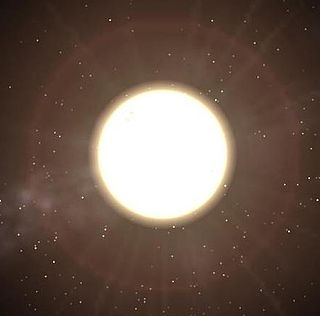
The Magellan Telescopes are a pair of 6.5-metre-diameter (21 ft) optical telescopes located at Las Campanas Observatory in Chile. The two telescopes are named after the astronomer Walter Baade and the philanthropist Landon T. Clay. First light for the telescopes was on September 15, 2000 for the Baade, and September 7, 2002 for the Clay. A consortium consisting of the Carnegie Institution for Science, University of Arizona, Harvard University, the University of Michigan and the Massachusetts Institute of Technology built and operate the twin telescopes. The telescopes were named after the sixteenth-century Portuguese explorer Ferdinand Magellan.

HD 12661 is a G-type main sequence star in the northern constellation of Aries. The star is slightly larger and more massive than the Sun, with an estimated age of seven billion years. It has two known extrasolar planets.
HD 28185 is a yellow dwarf star similar to the Sun located 128 light-years away from Earth in the constellation Eridanus. The designation HD 28185 refers to its entry in the Henry Draper catalogue. The star is known to possess one long-period extrasolar planet.

HD 28185 b is an extrasolar planet 128 light-years away from Earth in the constellation of Eridanus. The planet was discovered orbiting the Sun-like star HD 28185 in April 2001 as a part of the CORALIE survey for southern extrasolar planets, and its existence was independently confirmed by the Magellan Planet Search Survey in 2008. HD 28185 b orbits its sun in a circular orbit that is at the inner edge of its star's habitable zone.
HD 183263 b is an extrasolar planet orbiting the star HD 183263. This planet has a minimum mass of 3.6 times more than Jupiter and takes 625 days to orbit the star. The planet was discovered on January 25, 2005 using multiple Doppler measurements of five nearby FGK main-sequence stars and subgiants obtained during the past 4–6 years at the Keck Observatory in Mauna Kea, Hawaii. These stars, namely, HD 183263, HD 117207, HD 188015, HD 45350, and HD 99492, all exhibit coherent variations in their Doppler shifts consistent with a planet in Keplerian motion, and the results were published in a paper by Geoffrey Marcy et al. Photometric observations were acquired for four of the five host stars with an automatic telescope at Fairborn Observatory. The lack of brightness variations in phase with the radial velocities supports planetary-reflex motion as the cause of the velocity variations. An additional planet in the system was discovered later.
HD 102272 is a star in the equatorial constellation of Leo. With an apparent visual magnitude of 8.69, it is too faint to be visible to the naked eye. The syat is located at a distance of approximately 1,140 light years based on parallax measurements, but is drifting closer to the Sun with a radial velocity of −12 km/s. As of 2008, two extrasolar planets are known to orbit the star.
HD 154672 b is an extrasolar planet located approximately 210 light-years away in the constellation of Ara, orbiting the metal-rich and aged star HD 154672. This planet has a minimum mass five times that of Jupiter and orbits at about 60% the distance between the Earth to the Sun. Its orbit is very elliptical, which causes temperatures on the planet to vary significantly as it proceeds along its orbit. This planet was discovered in Las Campanas Observatory on September 5, 2008 using the radial velocity method. Along with HD 205739 b, the planets were the first to be discovered by the N2K Consortium using the Magellan Telescopes.
HD 143361 b is an exoplanet located approximately 224 light-years away in the constellation of Norma, orbiting the 9th magnitude G-type main sequence star HD 143361. This planet has a minimum mass of 3.0 times that of Jupiter. Because the inclination was initially unknown, the true mass was not known. This planet orbits at a distance of 2.0 AU with an orbital eccentricity of 0.18.
HD 43848 is a 9th magnitude K-type subgiant star located approximately 123 light-years away in the constellation of Columba. The star is less massive than the Sun.
HD 48265 is the Henry Draper Catalogue designation for a star in the southern constellation Puppis. It has an apparent visual magnitude of 8.07, which makes it too faint to be seen with the naked eye. Based upon parallax measurements made during the Hipparcos mission, it is located at a distance of roughly 293 light-years from Earth.
HD 143361 is a star in the southern constellation Norma. With an apparent visual magnitude of 9.20, this star is too dim to be seen with the naked eye. It is close enough to the Earth that its distance can be determined using parallax measurements, yielding a value of 224 light-years.
HD 204313 b is an extrasolar planet which orbits the G-type main sequence star HD 204313, located approximately 155 light years away in the constellation Capricorn. This planet orbits the star at a distance of 3.082 astronomical units and takes 1931 days or 5.29 years to revolve around the star. It has a minimum mass four times that of Jupiter. However the radius is not known since this planet was not detected by the transit method or direct imaging. Instead, this planet was detected by the radial velocity method using the CORALIE Echelle spectrograph mounted on the 1.2 meter Euler Swiss Telescope located at La Silla Observatory in Atacama desert, Chile on August 11, 2009.
HD 86226 is a star with a pair of orbiting exoplanet companions, found in the constellation of Hydra. With an apparent visual magnitude of 7.93, it is too dim to be visible with the naked eye. The distance to this system has been determined by the parallax method, yielding a range of 149 light years. It is receding with a heliocentric radial velocity of +19.6 km/s. A survey in 2015 has ruled out the existence of any stellar companions at projected distances above 12 astronomical units.

HD 129445 is a G-type star found in the Circinus constellation located 219 light-years away from the Sun based on parallax. It is invisible to the naked eye with an apparent visual magnitude of 8.80. The star was observed by the Magellan Planet Search Program due to its absolute visual magnitude and high metallicity. The Magellan program conducted 17 doppler velocity measurements, which spans a full orbital period. The results led the program to detect a planet dubbed HD 129445 b. In 2023, the inclination and true mass of HD 129445 b were determined via astrometry.
HD 129445 b is an eccentric Jupiter gas giant exoplanet orbiting the star HD 129445 which was discovered by the Magellan Planet Search Program in 2010. Its minimum mass is 1.6 times Jupiter's, and it takes 5 years to complete one orbit around HD 129445, a G-type star approximately 219 light years away. In 2023, the inclination and true mass of HD 129445 b were determined via astrometry.
HD 164604 is a single star in the southern constellation of Sagittarius constellation. It has the proper name Pincoya, as selected in the NameExoWorlds campaign by Chile, during the 100th anniversary of the IAU. Pincoya is a female water spirit from southern Chilean mythology who is said to bring drowned sailors to the Caleuche so that they can live in the afterlife. A 2015 survey ruled out the existence of any additional stellar companions at projected distances from 13 to 340 astronomical units. It is known to host a single super-Jupiter exoplanet.
HD 164604 b is an extrasolar planet discovered in January 2010 in association with the Magellan Planet Search Program. It has a minimum mass 2.7 times the mass of Jupiter and an orbital period of 606.4 days. Its star is classified as a K2 V dwarf and is roughly 124 light-years away from Earth.
HD 175167 is a star with an exoplanet companion in the southern constellation of Pavo. It is too faint to be visible with the naked eye at an apparent visual magnitude of 8.01. The system is located at a distance of 232 light-years from the Sun based on parallax measurements, and it is drifting further away with a radial velocity of 5 km/s. It shows a high proper motion, traversing the celestial sphere at an angular rate of 0.190 arcsec yr−1.
HD 175167 b is an exoplanet orbiting HD 175167, which is a G type star within the Pavo constellation 232 light-years away from the Earth. The planet was discovered by the Magellan Planet Search Program as the astronomical object fit the Keplerian orbital model. During the observations 13 doppler velocity tests were conducted, which showed this object's mass was at least 7.8 Jovian-masses and its orbit has a high eccentricity. The exoplanet takes 3.53 years to complete a full stellar orbit.
HD 86226 b is a gas giant exoplanet discovered by the Magellan Planet Search Program in 2010. It was confirmed in data collected by the CORALIE spectrograph on the Swiss 1.2-metre Leonhard Euler Telescope in 2012. It takes about 4.6 years to orbit its G-type star and was initially believed to have a minimal mass of 0.92 Jupiters. Discovery of the second planet in the system has led to the revised mass of HD 86226 b in 2020, now estimated to be 0.45+0.04
−0.05MJ.






